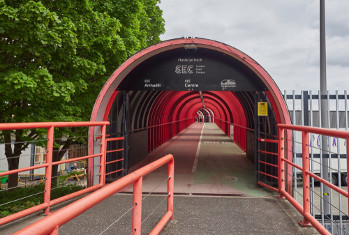Scotland is set to take a risk-based approach to cycling infrastructure design in its official guidance from next year in an attempt to provide greater protection to cyclists and pedestrians.
An updated version of Cycle by Design by Transport Scotland, local government officers’ body SCOTS and active travel charity Sustrans is due to be released in 2020.
Cash from scheme sponsors, Sustrans, will be dependent on authorities using the guidance.

A cycleway close to Traffex Scotland venue the SEC, Glasgow
It will introduce a risk-based approach where traffic volumes and speeds are among several factors designers must consider when making decisions, a consultant on the project revealed at Traffex Scotland this year.
Andrew Kelly is associate director at Jacobs, which was appointed in 2016 to update the guidance document – initially for trunk roads only but the remit widened after an active travel task force convened in 2017 to understand some of the barriers Scotland had to achieve its active travel.
‘Rather than be prescriptive about the infrastructure – we are inviting people to consider where the risk lies. We want a clearer association of these decisions to the key design principles of safety, coherence, directness, comfort, attractiveness and adaptability,’ Mr Kelly said.
Additional consideration of risk include:
- Vehicle risk unit
- Light segregation for on-carriageway cycle lanes/tracks
- On-carriageway protection for on-street parking
- Frequency of junctions and accesses
- User destinations
Particular design challenges the refresh aims to address:
- How to provide a greater level of protection for cyclists
- How to provide a greater level of coherence of routes – joined up network consistency of cycle infrastructure
- How to provide priority for pedestrians cyclists across minor accesses and side roads
- How to manage pedestrian and cycle conflicts at key junctions
- How to design for cyclists safety at junctions (protected junctions signal control roundabouts)
The document aims to give greater priority for cycle users, having identified a ‘clear link between the need to stop regain momentum and lack of attractiveness of cycling’, although Mr Kelly added this cannot be at the expense of pedestrians.
As part of this cyclists could be given priority across a side road where existing side road speeds and traffic volumes are low and where full visibility can be achieved.
Junction safety
Equally designing for greater cycle safety at junctions will be another area ‘where we really have to improve what we have’.
There are already various examples of protected cycle infrastructure at junctions used in Europe and the new guidance will look to identify ‘not just on geometric design but one the conditions to apply these’ Mr Kelly said.
The desired outcome would be ‘full visibility between vehicle drivers and cycle users, slowing of traffic, coherence and commonality’.
Draft content were due to go out to a working group review between November 2019 and March 2020, with a targeted consultation on specific designs aspects during the same period.
Following this there will be collation of feedback from April with a view to publishing in June.
The current version of Cycle by Design was published in 2011 and despite being required to be used by designers on the trunk network and being commended to local authorities, it is overdue a refresh.
‘A lot has changed over last eight years and not every local authority is using Cycle by Design because it is not the most relevant and up to date document,’ Mr Kelly said.
There is a government target for 10% of all trips to be made by walking and cycling by 2020, and the devolved nation is almost certainly going to fall short of that as it is currently only on around 1.5%.
Register now for full access
Register just once to get unrestricted, real-time coverage of the issues and challenges facing UK transport and highways engineers.
Full website content includes the latest news, exclusive commentary from leading industry figures and detailed topical analysis of the highways, transportation, environment and place-shaping sectors.
Use the link below to register your details for full, free access.
Already a registered? Login